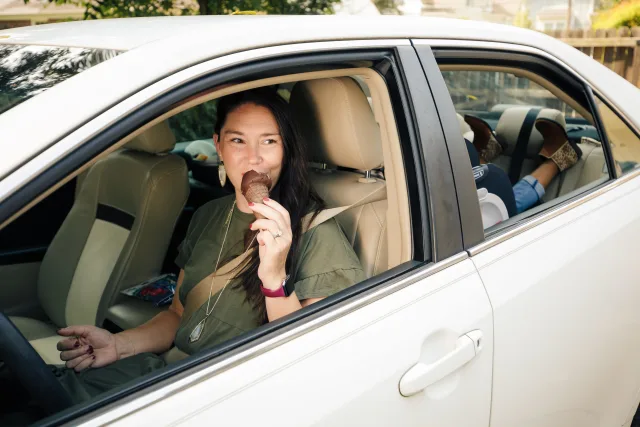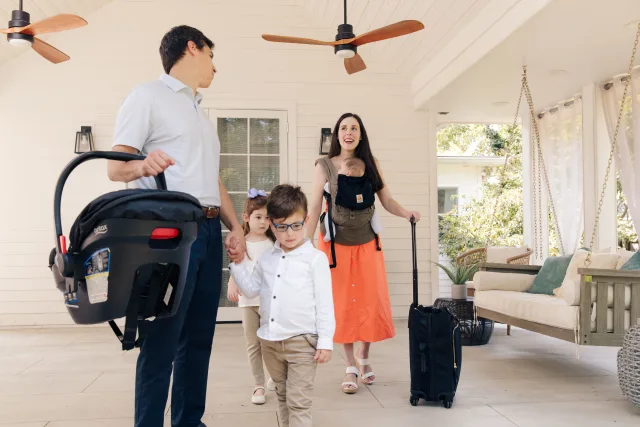Summer is the perfect time for a great adventure with your family. Whether you’re planning a magical Disney experience or a daring Yellowstone hiking trip, you’ll need a place to stay and a way to get around! This is why RVs are one of America’s favorite travel tools. It’s one of the best ways to save money and bring all the comforts of home with you while you explore the world! Right?!
Well…no. We hate to be the fun-sucker in the room, but when planning your next family road trip, safety has to be a top priority. Unfortunately, there are a lot of safety concerns with these big rigs. So today, we’ve dedicated a post to RV travel and answering the question: Are RVs safe for kids? Let’s find out:
Are RVs Safe for Kids?
Though RVs seem super convenient on the surface, they are not safe for children. To be blunt, there is no way to safely buckle your kiddos into most Class A, B, or C recreational vehicles. Beyond the cab, the RV’s seats do not meet the requirements of federal motor vehicle safety standard 208, which regulates seatbelts in passenger vehicles to ensure the greatest level of safety on our roads.
In RVs, instead of the seat belts being attached to the frame of the vehicle, the belts bolt to the wooden floor. Because of this, seat belts often break free during crash events. These seatbelts are more decorative than functional, and they won’t protect an occupant — whether that’s an adult or a child in a car seat.
Even if these seatbelts were suitable for passenger use, most of them are still useless for car seats. Why? Because so many RV seatbelts are on sideways-facing vehicle seats, while car seats must be installed on a vehicle seat that faces the front of the rig. This is how car seats are designed and crash tested. They aren’t engineered or tested for impacts in a sideways-facing installation setup, so there’s no way to predict whether that car seat would protect the child during a crash.
Understanding the Risks
When considering RV travel, it’s important to recognize that RVs, including motorhomes, travel trailers, and fifth wheels, are not held to the same safety standards as passenger vehicles. Unlike passenger cars, RVs are not required to undergo crash testing or adhere to the stringent safety regulations that apply to traditional vehicles. This lack of regulation means that the safety features found in your family car, such as crumple zones, airbags, and advanced seatbelt systems, may not be present in an RV.
Key risks include:
- Lack of crash testing: Most RVs are not crash-tested, so their structural integrity in a collision is unknown.
- Inadequate seatbelts: Seatbelts in RVs may not meet the same safety standards as those in passenger vehicles.
- Furniture and appliances as hazards: In a crash, unsecured items like furniture and appliances can become dangerous projectiles.
Where Should Kids Ride in an RV?
One of the most critical questions parents have is where kids should ride while the RV is in motion. The safest place for children to ride is in the cab of the towing vehicle (if you’re using a travel trailer or fifth wheel) or the driver’s compartment of a motorhome, where seatbelts meet federal safety standards. This area is typically designed with crash safety in mind, similar to a passenger car.
Avoid these common mistakes:
- Riding in the rear of the RV: Many parents believe that kids can ride in the living area of the RV, but this is not recommended. The rear of an RV often lacks proper seatbelts and is not designed for safety during travel.
- Improper use of booster seats: If your child uses a booster seat, it’s important to ensure that the seatbelt fits properly and that the seat is installed in a location that meets safety requirements. Booster seats are only effective when used with lap-and-shoulder seatbelts that fit correctly.
New Tips for Securing Kids Safely
To maximize safety, follow these updated guidelines:
- Use the right car seats: Children should be in an appropriate car seat or booster seat for their age, height, and weight. Ensure the car seat is securely installed in the safest position available, ideally in the cab of the vehicle towing the RV or the driver’s compartment of the motorhome.
- Avoid the front passenger seat: If possible, avoid placing children in the front passenger seat of the RV or towing vehicle. The rear seats are generally safer, especially in the event of a frontal collision.
- Secure all loose items: Before hitting the road, make sure that all loose items, including toys, electronics, and even larger items like strollers or coolers, are securely fastened. RVs are full of dangerous projectiles. In the event of a sudden stop or collision, these items could become projectiles. Consider using cargo nets or bungee cords to keep everything in place.
- Update your emergency kit: In addition to standard emergency supplies, consider adding items specific to RV travel, such as a tire repair kit, a portable battery charger, and extra water. Make sure your emergency kit is easily accessible and that everyone knows where it is located.
- Perform regular safety checks: Before each trip, inspect your RV or travel trailer thoroughly. Check that all seatbelts are functioning correctly, the tires are in good condition, and the hitch or towing setup is secure. Regular maintenance is key to preventing accidents.
- Educate your kids: Teach your children the importance of staying seated and buckled up at all times when the RV is moving. Explain that the RV is like a moving car, not a place to walk around or play games while in motion.
- Learn your state’s RV safety laws: Having a child correctly buckled into a seat belt per the manufacturer’s instructions is required in most states. This means buckling your child, who is meant to be in a rear-facing car seat, into a side-facing vehicle seat might not only be unsafe but illegal. Check your state’s child passenger safety laws to ensure whatever decision you make is by the book.
Alternative to Kids Riding in an RV: Drive a separate vehicle with the kids.
If you decide to keep your motorhome, simply take two vehicles. One adult can drive the RV while the other drives a standard, regulated passenger vehicle. When you do this, you’ll know that all your car seats and boosters are doing their job and protecting your children. We’ve even got some tips for road trips with kids here if you’re nervous about riding alone with them.
Once parked at your destination, you won’t want to drive your motorhome to your various excursions and errands. You’ll want your regular vehicle, anyway! Instead of towing it, take it separately. Your family still gets the RV lifestyle, but you have peace of mind. Everyone is safe, and everyone is happy!
Additional Safety Considerations
- Drive cautiously: RVs and travel trailers are heavier and more challenging to maneuver than passenger cars. Driving at a slower speed gives you more time to react to unexpected situations and reduces the risk of accidents.
- Be mindful of your surroundings: Always be aware of your surroundings, especially when parking or backing up your RV. Consider using a spotter or investing in a backup camera to avoid accidents in tight spaces.
- Plan for emergencies: Make sure you have an emergency plan in place, including a designated meeting spot outside the RV in case of a fire or other emergencies. Practice this plan with your children so they know what to do if something goes wrong.
Final Thoughts
RVs can offer a fun and flexible way to travel with your family, but it’s essential to prioritize safety. By understanding the risks and taking steps to mitigate them, you can help ensure that your family’s RV adventures are as safe as they are enjoyable.
If you’re considering a trip with your kids in an RV, take the time to evaluate the safety features and understand the potential risks. Always prioritize placing your children in the safest location, and never compromise on the proper use of car seats and seatbelts.
RVs aren’t safe. They don’t fare well in crashes, they don’t have safe seats, and they’re full of dangerous projectiles. Even the Manufacturers Alliance for Child Passenger Safety (MACPS) confirms the safety concerns of RVs and states children should not ride in them. They agree with us here at Safe in the Seat—buy an amazing towable camper and continue your plans with a safe setup for all your passengers!
If you’re still confused about RV safety and how to use your car seat, we recommend you speak with a car seat consultant! They can give you recommendations, advice, and training on your car seat. Advice that’s personalized to you, your experience, your seat, and your child. They’ll answer any other questions you have about road-tripping to make traveling totally stress-free.
Wondering where else you can or can’t use your child’s car seat? From airplanes and rideshares to RVs and rental cars, we break it all down in our blog post: Where Can You Use a Car Seat?. It’s the go-to guide for knowing when your seat can legally and safely be used and when it can’t.
For more information on general vehicle safety, check out our blog and Instagram. We discuss all things car seat safety because there are so few resources out there to find true car seat education. Also check out our post on Golf Cart Safety for Kids here. It’s our goal to share knowledge about car seat safety with women everywhere, so all your kiddos can be safe in their seats! Let’s make the world safer, one caring mom at a time.






